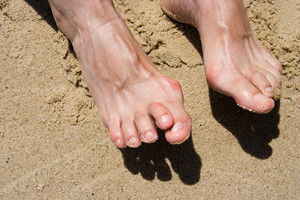
Some people are born with crooked toes, and others acquire them over time. Common types of crooked toes are curly toes, hammertoe, mallet toe, claw toe, overlapping toe, and adductovarus toe. Curly toes are generally congenital, where the third or fourth toe of the foot curls under the foot. A hammertoe has an imbalance in the ligaments, tendons, and muscles of the toe, causing the middle joint to pop up. In a mallet toe, the joint closest to the toenail pops up and curls under the foot. It may result from wearing shoes that are too tight or shoes with high heels. Claw toes bend under the foot, and may even dig into the sole of the foot. Aside from being painful, they can cause corns and calluses to form. An overlapping toe sits on top of the toe next to it. This may cause pain when wearing closed shoes and inhibit walking. An adductovarus toe tries to move beneath the toe next to it. This is more common in the fourth or fifth toe and can be a direct result of wearing shoes with a pointy toe box. If you have any of these toe deformities that are causing pain or inhibiting your daily activities, it is a good idea to consult with a podiatrist for treatment options.
Toe pain can disrupt your daily activities. If you have any concerns, contact Dr. Mark Gagnon of Advanced Podiatry. Our doctor can provide the care you need to keep you pain-free and on your feet.
What Causes Toe Pain?
Most severe toe pain is caused due to a sports injury, trauma from dropping something heavy on the toe, or bumping into something rigid. Other problems can develop over time for various reasons.
Toe pain can be caused by one or more ailments. The most common include:
- Trauma
- Sports injury
- Wearing shoes that are too tight
- Arthritis
- Gout
- Corns and calluses
- Hammertoe
- Bunions
- Blisters
- Ingrown toenails
- Sprains
- Fractures (broken bones)
- Dislocations
When to See a Podiatrist
- Severe pain
- Persistent pain that lasts more than a week
- Signs of infection
- Continued swelling
- Pain that prevents walking
Diagnosis
In many cases the cause of toe pain is obvious, but in others, a podiatrist may want to use more advanced methods to determine the problem. These can range from simple visual inspections and sensation tests to X-rays and MRI scans. Prior medical history, family medical history, and any recent physical traumatic events will all be taken into consideration for a proper diagnosis.
Treatment
Treatments for toe pain and injuries vary and may include shoe inserts, padding, taping, medicines, injections, and in some cases, surgery. If you believe that you have broken a toe, please see a podiatrist as soon as possible.
If you have any questions please feel free to contact one of our offices located in Crestwood, Orland Park, and Summit, IL . We offer the newest diagnostic tools and technology to treat your foot and ankle needs.
